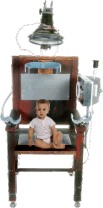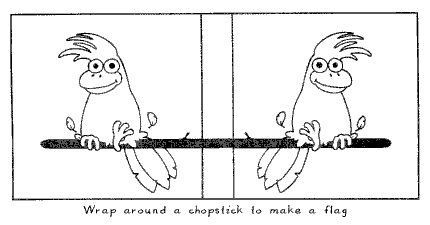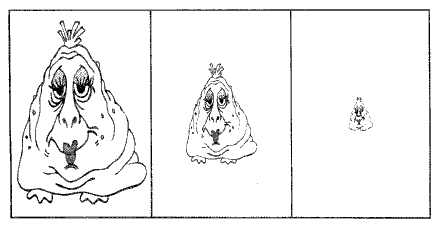
Injustice anywhere is a threat to justice everywhere.
Martin Luther King (1957-1968)
letter from Birmingham city jail, 1963
Beyond Repetition
If speaking is silver, then listening is gold.
Turkish Proverb
Do parrots make good listeners? One of the problems with teaching children is the fact that they often repeat everything you say. It's as if they believe that repetition is communication. Of course this isn't what's really happening. Children repeat what teachers say because that's what they think they should do. They think repetition is expected of them. This time around I want to focus on some of the things I do to encourage children to break out of the parrot syndrome and actually learn to listen for real meaning.
As friends, we don't see eye to eye, but then we don't hear ear to ear either.
Buster Keaton
The most important thing we can do to help children listen is to give them something worth listening to. I'll come to that presently. But first it is necessary to differentiate between the time when we want them to repeat and the time when we want them to listen and respond. For this I use a parrot flag. Whenever I do repetition I use the flag. In NLP (Neuro Linguistic Programming) terms the flag is an anchor. In the same way that many teachers start with a hello song and end with a goodbye song the parrot flag signals to the children that it's time for a particular kind of activity to take place. In the case of the parrot flag it's repetition.

The flag is more than a symbol. It can be used as a kind of conductor's baton. I raise it high for a high voice and lower it for a low voice. I vary my voice a lot when doing repetition. I use the parrot flag to give visual clues and feedback to the children. I expect them to mimic my voice as accurately as they can. This goes beyond pronunciation but extends to pitch and voice timbre. I'm encouraging the children to mimic me and this encourages them to listen closely. At this time there's no meaning attached to the sound, the focus is on the sound itself. Actual pronunciation is secondary. This can be tremendously liberating and entertaining for children. Freed from the worry of 'getting it right' they can learn to enjoy making strange sounds and using 'new' muscles to produce new sounds.
"Colour this Please!"
In many of my classes I spend a little time getting children to make their own parrot flags. With their own flags they can play repetition games with each other. I provide a blank flag for each child and give them some time to colour it.
Just handing over colour pens doesn't encourage interaction in English or co-operation so I usually give out just one pen per child when doing this activity. I give out the pens randomly in envelopes so each child ends up with a different colour. I pre-teach the phrase "Colour this please!" using (you've guessed it) my own parrot flag. I show a finished parrot so that children will see it is multicoloured. I show them how they can instruct each other to colour parts of each other's parrots. I'll demonstrate a few times and then let them get on with it.
Obviously this colouring game can use up more time than individual colouring and it's a good idea to agree a time limit with the children before starting the colouring. An alternative is to get them to make the parrot flags at home. But colours are easy to learn and a useful way into genuine listening.
For example, with beginners classes I'll play some games to check they know some colours and then we'll do a worksheet which involves the class colouring a sheet according to my instructions ("colour the cat pink, colour the carrot blue, colour the camera green" etc). Usually my colouring sheets have 6-8 vocabulary items. I colour at the same time. Afterwards we can check to see whose sheet matches mine. With this activity you'll need multiple sets of coloured pens or pencils.
When the procedure is established I'll get the children to take turns to instruct each other. I allow the children to choose what ever colours they like. It's OK if they all choose the same colour!
Finally I'll introduce some cards or a coloured dice. At this stage one child secretly rolls the dice or selects a colour card and gives instructions accordingly. This is more difficult than free choice because they have to remember the colour's name in English and then use it in a sentence.
Small talk deserves small talk responses.
Thomas G. Banville
Earlier I suggested that it's important to give children something worth listening to. In my experience children enjoy nonsense. In the past I've dressed up listening exercises as game shows Penguins live in my refrigerator, trucks and trains can be found in my toilet, old socks and garlic form the ingredients of witch stew. Surprises offer an incentive to listen.

One simple greeting game is to give out some 'monster' cards to the children. For example, you could have big, small and tiny monsters. Get the children to stand in a line. Start at the end of the line. The first child starts by 'meeting' the child on the left. As they shake hands they perform a dialogue. For example:
Child A:"Hello, I'm a tiny monster, nice to meet you"
Child B:"Hello, I'm a big monster, nice to meet you"
And they shake hands. Child B then begins the dialogue with the next child on the left. At any time either child can vary the reply and say "Nice to eat you!" At this point the pair try and tag other monsters. This won't be easy as they should remain holding hands! The other monsters can run to a safe area at the other end of the room.
A variation is to make matching monsters wild. For example, if a tiny monster says "Nice to eat you!" all tiny monsters now try to tag other monsters. Big and small monsters should run away.
For additional challenge colour the monsters. Now the phrase might be "I'm a small yellow monster, nice to eat you!" All small yellow monsters could go wild, but small green monsters, big yellow monsters etc, would run away.
A gentler monster game is to get the children sitting in groups of four. One player becomes "The Listener''. This player closes their eyes. One at a time the other three children describe themselves. The Listener listens to all three and then repeats the information gesturing to the others in turn. "You're a big red monster, you're a small blue monster, you're a tiny green monster". When the Listener has got this right the other children change places. The Listener then opens their eyes and repeats the information again gesturing to the right child. Children take it in turns to be the Listener.
Of course this activity doesn't need to be limited to monsters. Children can use real information. Use different sentence stems, for example "I can..." or "I like". Getting them to listen and repeat with their eyes closed is a powerful way to get them focused on listening.
The principle of listening, someone has said, is to develop a big ear, rather than a big mouth.
Howard G. and Jeanne Hendricks
Listening is one thing, showing that you are listening is another. Get children to use their bodies to show they understand (nods, shrugs and shakes). Vary simple question and answer sessions, sometimes insisting that only non-verbal communication is allowed. Play simple games in silence. Play with the tension that arises when speaking is natural but prohibited.
For example, get children to do a 20-30 piece jigsaw together. Divide the pieces between them. Make it a rule that they can't place their own pieces but must instruct others where the piece goes. See how many pieces they can place without talking. Agree a time limit but end the game immediately when someone talks!
Uh-huh
Connected to this idea is the Uh-huh game. This is played in pairs. Three flashcards are needed per pair. Use known vocabulary when introducing the game and practise the sounds ('Uh-huh and Uh-uh) using the parrot flag.
To play the first player takes the cards , shuffles them and holds them so the second player can see the bottom card. The first player states what it is. E.g. in the case of colours, "This is red." If the statement is correct the second player voices agreement "Uh-huh" (yes). If the statement is false the second player says "Uh-uh" (no). The card is placed on top revealing the second card and the process is repeated.
At no time should the first player look at the cards. The aim is to name all the cards correctly, i.e. to get three "uh-huh" answers in a row. Players then swap roles. When the children get good at this increase the number of cards or introduce a time limit. The game introduces English interjections and gives children practise at providing feedback. One of the arts of listening is showing that you really are listening.
October 2000
Altogether Now - Nice to Eat You
Column in Teachers Learning with Children
- Top Page
- Splog!
- Articles
- Games
- Across The Table
- Add One More
- Anaconda
- Be A Monster!
- Black Hole (board game)
- Bombs Away!
- Catch!
- Catch-Caught-Caught!
- Centipede
- Charades
- Co-operative Quiz
- Crocodile
- Dice Stack
- Fast Food Tag
- Find My Number
- Find The Penny
- Football
- The Happy Game
- Line Up!
- Maze Challenge
- Natty Narration
- Nose Nose Nose
- One Step Forward!
- Pair Fluency Match 7 - Death Wish
- Pair Fluency Match 7 - Go Green!
- Parrot Parade
- Passport Control
- Reach The Top!
- Snake
- SockIt!
- Tickle Time
- What Cards
- Which One?
- Whose Shoe?
- World Cup Football 2018
- You, You, Me!
- Wake Up
- Packs
- Sheets
- Songs and Music
- Strips (songs and otherwise)
- Stories
- Techniques
- Video
- Environment
- Japan
- The 75th Anniversay of the bombing of Hiroshima
- The 75th Anniversay of the bombing of Nagasaki
- Cars in Japan
- Coronavirus Olympics
- Forest Bathing
- Japan and the Summit
- Japan and World War Two
- Multiculural Japan?
- Olympics Two Tokyos
- Plastic in Japan
- Return to Fukushima
- The Anniversary too Important to Cancel
- Typhoon Jebi
- Yayoi Kusama's Infinity
- Other
- This Week In History
- January, February, March
- April, May, June
- Sub Menu Item
- This Week in History: April 8-10
- This Week in History: April 12-15
- This Week in History: April 19-24
- This Week in History: April 24-26
- This Week in History: May 6-11
- This Week in History: May 11-14
- This Week in History: May 18-23
- This Week in History: May 25-31
- This Week in History: June 1-5
- This Week in History: June 11-14
- This Week in History: June 22-27
- This Week in History: June 15-21
- This Week in History: June 29 - July 5
- July, August, September
- This Week in History: July 6-12
- Sub Menu Item
- This Week in History: July 14-19
- This Week in History: July 27-31
- This Week in History: August 2- 6
- This Week in History: August 17-21
- This Week in History: August 27-30
- This Week in History: August 31 - September 6th
- This Week in History: September 7-13
- This Week in History: September 22-27
- This Week in History: September 14-20
- This Week in History: September 28 - October 4
- October, November, December
- Quizes
- Vocab



